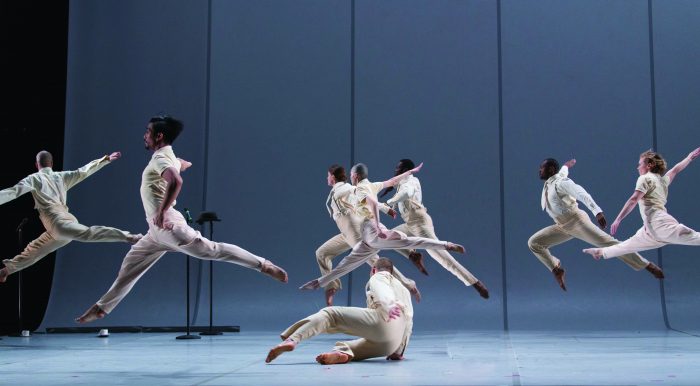By Leslie Holleran
“Where’s your interest?,” asked dancer I-Ling Liu of her artistic director, world-renowned choreographer Bill T. Jones, in 2013.
He was pondering the direction of a new work and quickly realized that his interest was in literature and W.G. Sebald’s acclaimed novel “The Emigrants” in particular. Liu’s simple, but pointed, question set the wheels in motion for the Bill T. Jones/Arnie Zane Company’s recent work, “The Analogy Trilogy.”
Completed in 2017, this four hour-long theatrical trilogy had its West Coast premiere February 1-3 at the University of Washington’s Meany Center. Its three related, but separate parts unfolded over three consecutive nights. The full work had its world premiere last summer at the American Dance Festival in Durham, NC. The Bill T. Jones/Arnie Zane Company, founded as a multicultural dance company in 1982, has performed 140 works in over 200 cities around the world.
The company’s appearance in Seattle was notable not only in terms of the work presented, but also the number of opportunities provided to learn from and engage with the artists. Bill T. Jones gave this year’s Danz Lecture at UW last Tuesday night, providing insight into what he was aiming to achieve in making the work, as well as its content and formal elements wherein the analogy resides. (The anecdote above regarding how the work began is from the lecture, which was recorded by KUOW.)
Regarding his intentions, Jones said at the lecture, “I want to make something achingly beautiful. I want to talk about things like life and death. I want to talk about aging. I want to talk about time. I want to talk about metaphor.”
The first piece in the trilogy was “Dora: Tramontane” about Dora Amelan, a 97 year-old Jewish woman and Holocaust survivor. Dora is also Jones’ mother-in-law. The text created for this piece comes from an oral history Jones made with her in 2002.
In the lecture, Jones called this piece “charming.” It’s certainly that. It opens and we hear Jones’ recorded voice talking to Dora. She’s telling a story about the sun and the moon and how they are never able to meet, because the sun insists on glowing. It’s sweet, but also layered with meaning. It serves as a reminder that we can’t have light without darkness. The piece as a whole recounts Dora’s experience from the invasion of Belgium by the Nazis to VE Day through music, including Schubert lieder and French songs, movement and text.
The company’s creative director, Bjorn Amelan, created a single set for each piece in the trilogy. The set design forms part of the analogy. White marley stage flooring is turned widthwise, so that one end covers the stage and the other is hung from the ceiling. The hanging portion also serves as a projection screen when video is shown. Another scenic element is a cube made of metal bars. In “Dora,” it serves as the barracks at the internment camps in southern France where she spent most of the war. She works with a resistance organization and tries to get Jewish children to safety.
Jones tells an altogether different story in the second part of the trilogy, “Analogy/Lance: Pretty aka the Escape Artist.” Here Jones creates a portrait of his nephew, Lance Briggs. As with Dora Amelan, Jones conducted an oral history with Briggs. However, interviews with his nephew occurred during the course of making the piece.
Once a scholarship student at the San Francisco Ballet School, we learn from a recorded interview that Lance dropped out when his addiction took over. He was still quite young. Then, he turns to high heels and go-go dancing in New York and London to support his habit. His alter-ego, “Pretty,” strikes poses, and hip-hop is the language the dancers speak.
If WWII shaped Dora’s life in significant ways as she was coming of age, then drugs and the means to support a costly habit – first sex with older men and then go-go dancing – did the same to Lance.
For the final section, Jones turns to the text that had set his creative process in motion, Sebald’s “The Emigrants.” He focuses specifically on the third section of the novel, called “Ambros Adelwarth,” about a German who emigrated to America in the early 20th century. [Note: I wished I had read the entire novel or at least this section before seeing Analogy/Ambros. It would have helped me to get more out of it.]
Ambros is hired by a wealthy Jewish family in New York to take care of their son, Cosmo Solomon. A large section of Analogy/Ambros has them traveling together from America to Europe by ship and then finally to Jerusalem. What seems to define Ambros the most is his relationship with Cosmo. Presumably, they were lovers.
The importance of journeying to Ambros’ story is foreshadowed at the beginning of this section by a single female performer who runs a lap around the stage. Movement becomes a metaphor for the story that is to come.
Movement and dance share equally with design, music and narrative in the telling of intimate stories in “The Analogy Trilogy.” The stories aren’t epic, but rather relevant to our times. Bill T. Jones may be a self-professed formalist, but it’s humanity at its most laudable and destructive that emerges in the stories he tells and his company performs.
